“Is there anything more beautiful than a beautiful, beautiful flamingo, flying across in front of a beautiful sunset? And he's carrying a beautiful rose in his beak, and also he's carrying a very beautiful painting with his feet. And also, you're drunk.” -Jack Handy
The diversity of the world's animals is one of the most fantastic natural marvels that life on Earth has delivered. From the sea to land to the air, there's no shortage of wonders to explore. Today, though, I want to talk to you about one of the most bizarre sights of nature, as the 1989 supergroup Strength in Numbers once played about, the
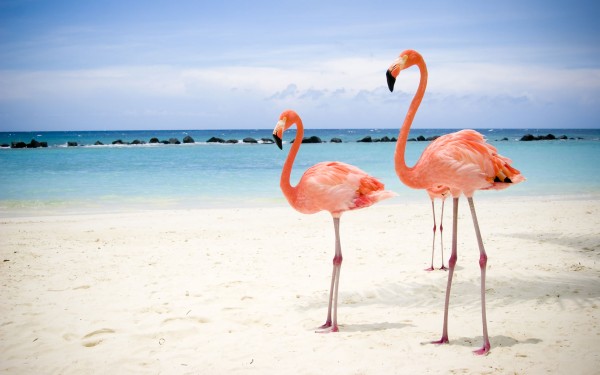 Image credit: Christine Pan of University of New Hampshire, via http://fermat.unh.edu/.
Image credit: Christine Pan of University of New Hampshire, via http://fermat.unh.edu/.
These tropical birds are unusual -- from a physical perspective -- for a number of reasons:
- their long, skinny legs,
- their distinctive, pink color,
- and their long, flexible necks.
But from a behavioral point of view, flamingoes are perhaps best-known for their unusual stance.
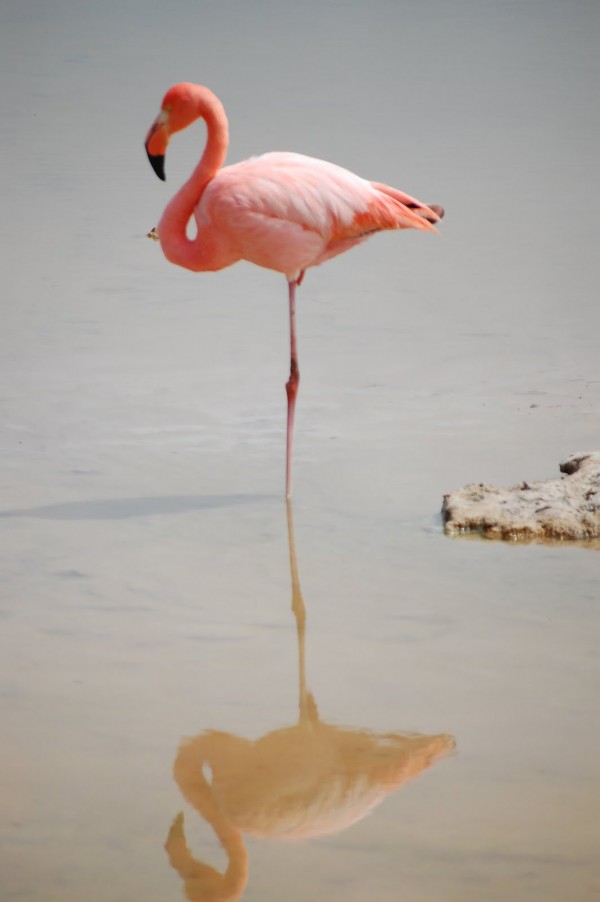 Image credit: Sarah Seads of http://elmhealth.blogspot.com/.
Image credit: Sarah Seads of http://elmhealth.blogspot.com/.
Flamingos typically feed by standing both feet in the water, muddying it to stir up seafloor creatures, and plunging their heads in to feed on algae, crustaceans, small fish, larvae and other tiny creatures. Shifting your feet to accomplish this requires both feet being in the water; flamingoes are not diving feeders like ducks are.
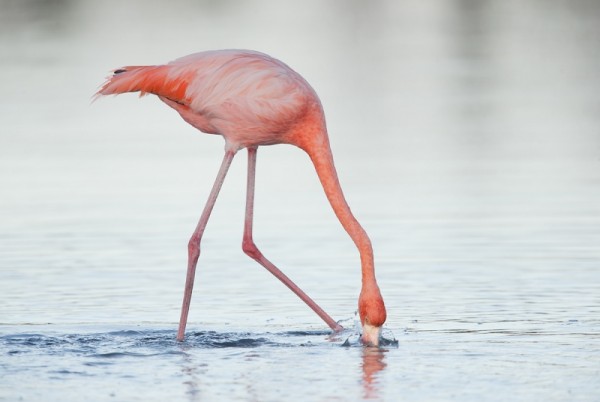 Image credit: Arthur Morris of http://www.birdsasart-blog.com/.
Image credit: Arthur Morris of http://www.birdsasart-blog.com/.
But when their beaks aren't plunging under the water, you'll almost never catch a flamingo with more than a single leg in the water unless it's cleaning itself.
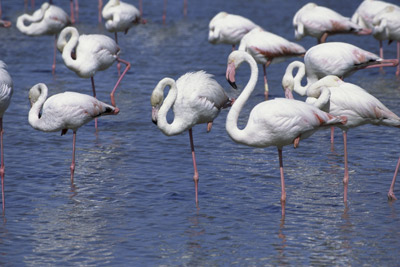 Image credit: Purestock / Getty Images, via http://animal.discovery.com/.
Image credit: Purestock / Getty Images, via http://animal.discovery.com/.
Some of the traits of flamingos are pretty easily explained, biologically and behaviorally. They usually (but not always) have a pink or red color based on the carotenoid pigments in the crustaceans and algae they eat; a dearth of this pigment results in paler, whiter flamingos.
The long legs and long necks work in tandem, and it's easy to see why evolution would favor these traits in flamingos: the longer their legs and necks are, the deeper the waters they can reliably feed in. If shallow-water food becomes scarce, it's the long-legged-and-necked flamingos that survive.
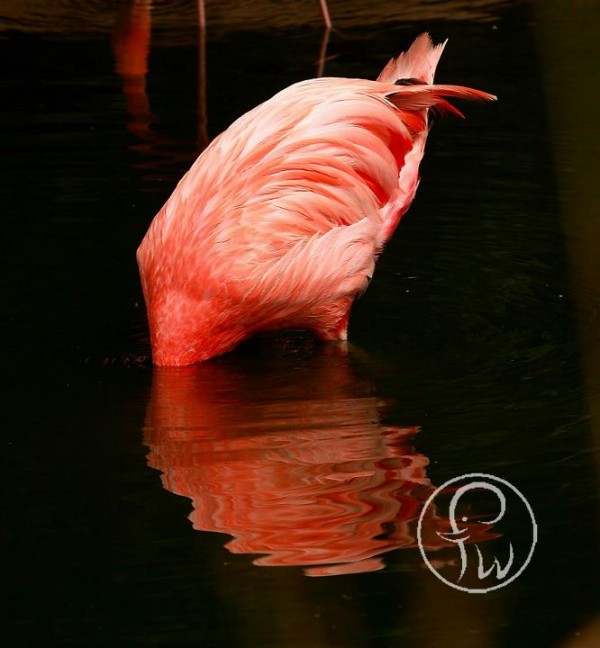 Image credit: Fort Worth Zoo blog, via http://www.safarisamblog.com/.
Image credit: Fort Worth Zoo blog, via http://www.safarisamblog.com/.
But what's the deal with the standing on one leg? Flamingos spend a lot of their time in the water, and whenever they're there and not actively feeding, you can find them standing on just one leg, something that they even sometimes do when they're on dry land.
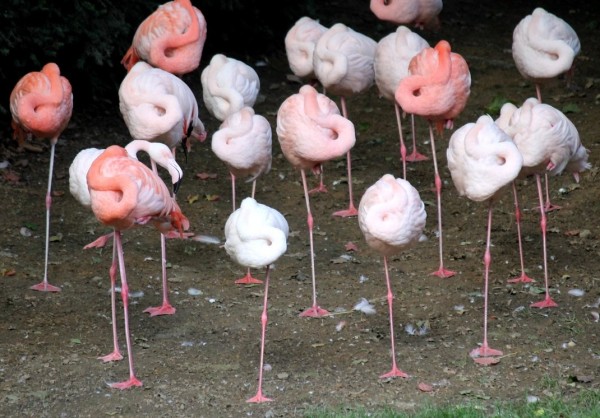 Image credit: ©2012-2013 eReSaW of deviantART, via http://eresaw.deviantart.com/.
Image credit: ©2012-2013 eReSaW of deviantART, via http://eresaw.deviantart.com/.
Why on Earth would it be advantageous for a flamingo to stand on one leg instead of two?
Because physics, that's why!
And it's physics that anyone who's ever been in the pool on a hot summer's day will understand all too well.
 Image credit: © Qmedia | http://Dreamstime.com/.
Image credit: © Qmedia | http://Dreamstime.com/.
Humans, like all mammals and birds (including flamingos), are warm blooded, and tend to be hotter than their surrounding environment. If you place an object like a warm-blooded creature in water, however, they lose their body heat 25 times faster than they do in air, and you lose that heat proportional to the amount of surface area in contact with it.
For a human, if you put just one foot in water up to your ankle (about 4% of your body's surface area), you'll lose as much heat through that one foot as you will through the entire rest of your body, assuming it's exposed to air of an equal temperature.
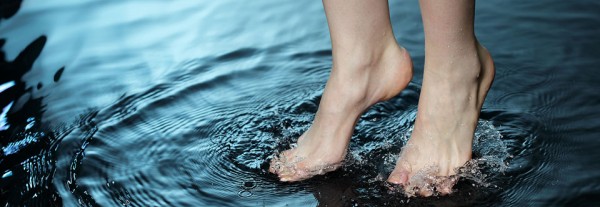 Image credit: Mountain Podiatry, via http://mountainpodiatry.net/.
Image credit: Mountain Podiatry, via http://mountainpodiatry.net/.
So for a flamingo? That one leg that's in the water is losing body heat quickly, and given the large surface area of its foot, it could even comprise the majority of a flamingo's body heat loss.
A flamingo that never learned to stand on one leg, that spent most of its time in the water with both legs immersed, would lose somewhere around 40-70% more body heat than a flamingo that did learn this behavior.
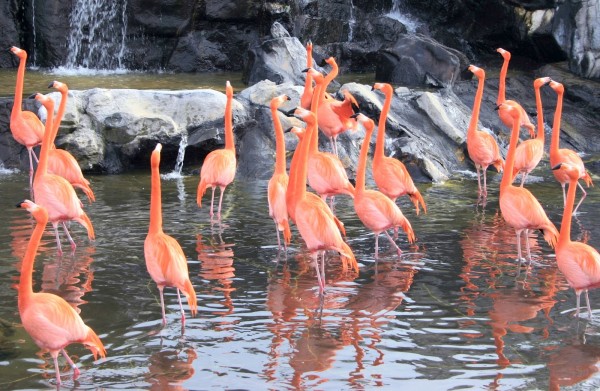 Image credit: Lilliput Review & Issa's Untidy Hut, via http://lilliputreview.blogspot.com/.
Image credit: Lilliput Review & Issa's Untidy Hut, via http://lilliputreview.blogspot.com/.
That means it's free to spend more time in the water, more time feeding, and enables it to have more chances for success at being a flamingo, just by standing on one leg. No wonder it's a behavior that gets passed down from flamingo-to-flamingo across the generations!
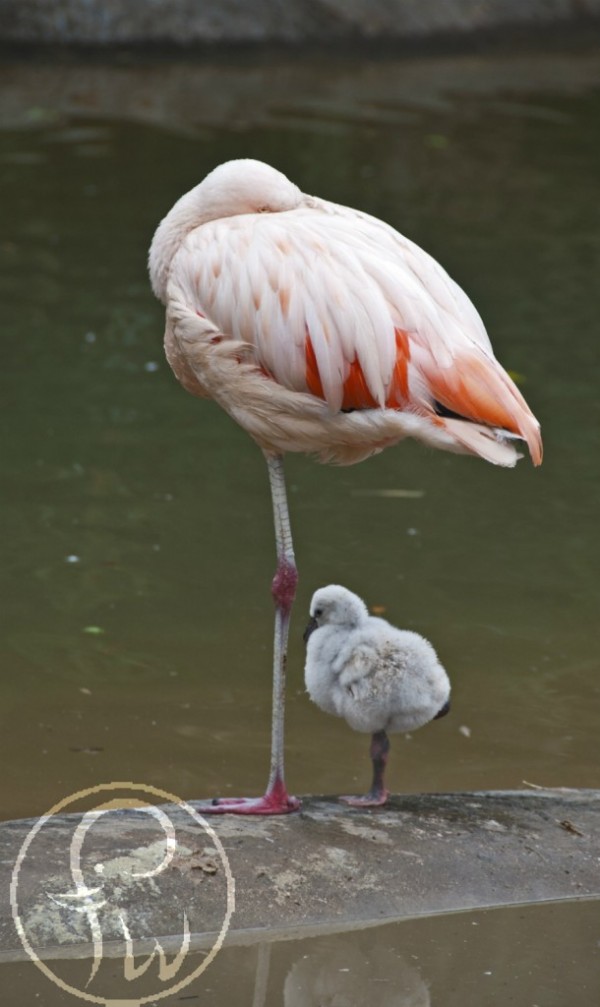 Image credit: Fort Worth Zoo blog, via http://www.safarisamblog.com/.
Image credit: Fort Worth Zoo blog, via http://www.safarisamblog.com/.
And that's one of the rare things in biology that we can figure out just thanks to some very simple physics! Hope you have a great weekend, and get to enjoy some of the wonders of the natural world. I'll see you back here for more about the Universe next week!

These calculations assume that the relative surface areas and patterns of blood-flow are the same for flamingo and human legs/feet, right? I would have thought that both are much lower in the flamingo - the legs look to be just bone, tendon and skin, with the musculature up high out of the water.
indeed. I believe that flamingos standing in ice-cold water have a heat-exchange system; so cold blood coming up is warmed by warm blood going down. By the time the blood returns to the body it has gained ~20ºC, while the blood going down cools and has less heat to lose while in the ice cold water. (see: http://wiki.ggc.usg.edu/wiki/Heat_exchangers_and_thermoregulation_in_ai…)
Many, if not most birds stand on one leg much of the time. My parrot, for instance, sleeps on one foot. The pyhsics is two-fold; balance and heat. When I switched from skiing to snow boarding it hit me, a single moment through the body's centre of gravity is more stable and more fun in an unstable environment like a swaying branch or a top heavy animal in the wind. Also, I'd like to know, when it's hot out and a flamigo has to cool its body, does it still stand on one leg? I'm guessing it's usually hot out where flamingos live and that they nevertheless stand on one leg. If I'm right, the physics of balance is primary. When Rufus flies over from having perched for a spell, one of his feet is warm, the other cold. It may be they're thinking more of keeping their feet warm, one at time.
Nice explanation Ethan. Thanks.
When you say, "a warm-blooded creature in water, however, they lose their body heat 25 times faster than they do in air, and you lose that heat proportional to the amount of surface area in contact with it."
I assume that you mean something like the following. We burn 25 time more calories per minute in 80 degree F water than in air.
Flamingos have always fascinated me. I was a tiny tot in the west of India , place called Veraval (Kathiawar). These birds used to land on a beach not far from us, going to or from a destination . I think my mother said " on the way to Africa to lay their eggs ." Could you please inform me if this is correct etc .thank you in anticipation
Yours sincerely ,
Gillian Jones ..
I am an avid birder and I have seen almost all shorebirds and wading birds do this some time or the other. I saw these Willets do this just a few weeks ago (http://www.flickr.com/photos/avkulkarni/9765112824/).
I have even seen gulls and ducks do it sometimes, but I never knew the exact reason. Next time I see this, I will keep an eye open to see if the temperature of air or water is especially colder than normal.
"I assume that you mean something like the following. We burn 25 time more calories per minute in 80 degree F water than in air."
No, our body has a maximum burn rate and the reason why people die in water even if rather warm (e.g. 21C) is because we can't produce energy quick enough to keep our core temperature within requirements.
We'd burn 2-3x as much by increasing our metabolic rate but lose 80x as much (then reducing the loss because our surface body temperature is dropping fast).
Wow
Aah. Makes sense. thanks.
... and if you are as old as I am, and ever had the privilege of seeing the group Jethro Tull in concert, you can never look at a flamingo without thinking of their leader, flautist Ian Anderson.
http://upload.wikimedia.org/wikipedia/en/1/1a/Tull_flute_pose_sil.jpg
so now the question is: are they right and left footed?
i have seen Jethro Tull twice. I know what you mean Patrick!
@ OKThen
in other words.. you can still get hypothermia and not loose weight :)
The heat exchange theory is most popular, but i've heard others, since flamingos are not the only ones (all crane family birds do).. even some ducks.
One is they shut down half of their brains when resting. Other is it eliviates the strain on heart to pump blood.
One thing to note is that birds will stand on one leg even when not in water, and even in desert temperatures (ibis birds)... so who knows.. they just might like it that way :)
Try working on your feet all day.
If you could stand on one foot for ages at a time, you'd do it..!
Given the habitats that most flamingos prefer (shallow salt flats in tropical environments), I rather suspect that there's something more going on here as well. They are probably more worried about overheating a good deal of the time.
Sinisia:
"They might just like it" could in fact be the adaptation - the mechanism that produces the result of better heat retention.
Evolution doesn't necessarily produce highly specific solutions to highly specific problems. Given the heat exchange issue Ethan discusses, I can see how a behavioral tendency to stand on one leg in general would probably be a positive adaptation. Indeed, the "sloppiness" of the adaptation (in that the birds don't seem to realize when it benefits them and when it doesn't) is pretty much what we might expect, if standing on one leg on land is not dangerous or does not cost a lot of energy.
@ eric
interesting viewpoint. haven't looked at it from that perspective. you might very well be right. a habit born out of real issue.
Not just birds. I think horses both stand and sleep with one hind leg gently resting on the point of its hoof, with all the weight on the other.
And humans do the same - you rarely stand with both legs bearing the same weight, usually one leg is straight and the other is slightly bent and only used for balance. Changing the used leg is good because standing still for too long puts strain on the cartilage in your joints (which deform time-dependently under constant load and also don't get a supply of nutriants when compressed); it might also help with fatigue in our muscles (the latter is not a problem for horses AFAIK since they have a locking mechanism that arrests the joint).
Question: What about penguins? Do they stand on the Snow on one foot or two?
Two, but mostly because they need to keep the egg off the ice. Since their feet aren't egg-cup shaped, that requires two feet to create a channel that stops the egg moving off the safe location and onto the deathly cold ice.
#5 Gillian Jones
I think your old lady is right, I've seen flamingos up the Great Rift Valley, and I believe the have a migratory pattern that takes them to India...